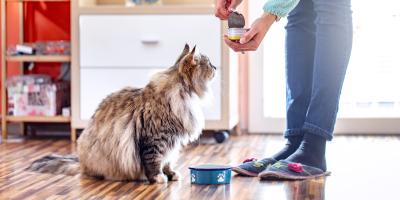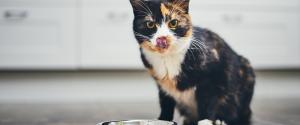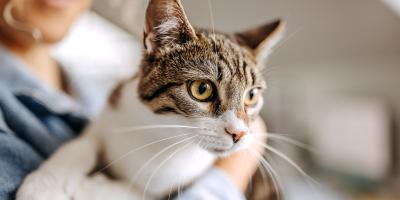
You probably already know that eating is one of a cat's favourite things to do. Occasionally, though, you'll find your cat needs a change in its diet. In this guide, we'll examine the reasons you might consider changing your cat's diet and how to switch cat food without disturbing your kitty's delicate system.
Reasons for Switching Cat Foods
Age. Ageing cats — those who are 7 years of age or older — should transition off of regular cat food to a senior diet that works to support immune system response and joint health.
On the flip side, kittens should start transitioning to adult cat food at about age 1. Before they're a year old, it's best to feed kittens specialized food that provides the nutrients and calories they need for healthy development. Continuing that same diet after the first year, though, can cause cats to quickly become overweight.
Weight. Just like humans, cats can end up dangerously underweight or overweight if they're not eating correctly. Sometimes you can solve the problem by simply feeding your cat more or less food.
If that doesn't work, specialized cat foods that feature healthy weight formulas can also help. Your vet can help you identify your cat's ideal weight and suggest the best diet to help achieve it.
Environment. Cats that are transitioning from an outdoor lifestyle to an indoor lifestyle should usually transition to a slightly different diet as well. Indoor cats don't get as much exercise and are also more likely to experience hairball issues related to more time spent grooming themselves.
Certain cat food formulas, such as Purina's Indoor formulas, can help decrease weight gain and ease discomfort related to changing environments.
Health. Cats that have sensitive tummies or suffer from itchy skin conditions that make them aggressively scratch themselves may benefit from a change in their diets. Additionally, cats that have been neutered tend to be more at risk of urinary tract infections. Certain Purina formulas offer specific support for urinary tract health.
Be sure to consult your vet to confirm that any health issues you've noticed are related to food intake. In some cases, such issues are better addressed through medication.
How to Transition a Cat to a New Food
Slow and steady is the way to go when transitioning your cat to a new food. This way, your cat's digestive system is more likely to correctly adjust to the new ingredients and stomach upset issues are less likely to crop up. The whole process should take about 10 days.
On the first two days of the transitioning process, you should primarily feed your cat the previous diet. Aim for approximately 25% new diet and 75% old. On the third and fourth days, serve the new diet and old diet in equal amounts. On the fifth, sixth and seventh days, move to 75% new diet and 25% old. By the last three days of the process, you should be exclusively serving the new food.
While most cats should be able to adjust to a new diet in this timeframe, all cats are different. Watch your cat's reactions to the new diet carefully. If your cat exhibits signs of digestive discomfort or seems reluctant to eat the new food, you can extend one of the stages by a few days or even drop back to an earlier one. Ask your vet for guidance if your cat seems consistently unwilling to eat the new food.
Tips on How to Switch Cat Food
As any cat lover knows, cats can be finicky creatures. Sometimes the reason your cat is reluctant to dig into a new diet isn't directly related to the unfamiliar food itself. If you're having trouble convincing your cat to take the plunge, check a few environmental elements.
Try to feed your cat at the same time and in the same location each day. Cats enjoy having a regular routine and can become confused or frustrated when they're fed at times they're not expecting.
Cats don't like having to eat near their litter boxes, so place the food across the room from their tray or in a different room entirely. Similarly, cats don't like eating from dirty surfaces. Always use a clean plate, bowl or saucer when feeding your kitty. Ceramic and metal bowls are the easiest to keep clean.
Some cats can get fairly territorial around their food. If you have multiple cats, it's best to place their food bowls fairly far away from each other to head off a potential clash. This is particularly important if you're trying to make certain your cats are on different diets. Separate feeding rooms and closed doors may be necessary if your cats are particularly curious about each other's meals.
Switching Between Dry Food and Wet Food
Assuming there's no medical condition involved, the question of whether you should serve your cat wet food or dry food mostly comes down to your cat's preference. One isn't inherently better than the other, and a mix is fine. However, it's important to know about some specific issues that may crop up when switching between an exclusively dry-food diet and a wet-food one.
A switch from wet food to dry means your cat's meals become slightly less hydrating. That, in turn, means you should set out slightly more water for your cat every day. Cats that are switching from wet food to dry may choose to graze on their meals throughout the day rather than eating them in a single sitting.
The reverse is also true. A cat switching from dry food to wet food will likely drink less water than before. They'll also be more likely to eat more quickly and polish off their food all at once.
Related articles



